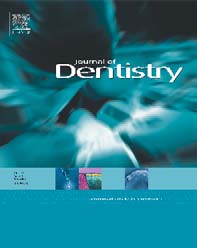Pii: s0197-2456(00)00134-3
Calculating Confidence Intervals for the Number Needed to Treat Ralf Bender, PhD Department of Epidemiology and Medical Statistics, School of Public Health, University of Bielefeld, Bielefeld, Germany ABSTRACT: The number needed to treat (NNT) has gained much attention in the past years as a useful way of reporting the results of randomized controlled trials with a binaryoutcome. Def



 j o u r n a l o f d e n t i s t r y x x x ( 2 0 0 6 ) x x x – x x x
a v a i l a b l e a t w w w . s c i e n c e d i r e c t . c o m
j o u r n a l h o m e p a g e : w w w . i n t l . e l s e v i e r h e a l t h . c o m / j o u r n a l s / j d e n
The bleaching of teeth: A review of the literature
Unilever Oral Care, Quarry Road East, Bebington, Wirral, CH63 3JW, UK
Objectives: To review current knowledge of tooth whitening with respect to external
Data: The scope is the external bleaching of vital teeth and focuses on mechanisms; in vivoand in vitro measurement methods, and factors influencing the efficacy of the whiteningprocess.
j o u r n a l o f d e n t i s t r y x x x ( 2 0 0 6 ) x x x – x x x
a v a i l a b l e a t w w w . s c i e n c e d i r e c t . c o m
j o u r n a l h o m e p a g e : w w w . i n t l . e l s e v i e r h e a l t h . c o m / j o u r n a l s / j d e n
The bleaching of teeth: A review of the literature
Unilever Oral Care, Quarry Road East, Bebington, Wirral, CH63 3JW, UK
Objectives: To review current knowledge of tooth whitening with respect to external
Data: The scope is the external bleaching of vital teeth and focuses on mechanisms; in vivoand in vitro measurement methods, and factors influencing the efficacy of the whiteningprocess. j o u r n a l o f d e n t i s t r y x x x ( 2 0 0 6 ) x x x – x x x
Heat and light . . . . . . . . . . . . . . . . . . . . . . . . . . . . . . . . . . . . . . . . . . . . . . . . . . . . . . . . . . . . . . . . . . . . . . . . . . .
j o u r n a l o f d e n t i s t r y x x x ( 2 0 0 6 ) x x x – x x x
Heat and light . . . . . . . . . . . . . . . . . . . . . . . . . . . . . . . . . . . . . . . . . . . . . . . . . . . . . . . . . . . . . . . . . . . . . . . . . . . j o u r n a l o f d e n t i s t r y x x x ( 2 0 0 6 ) x x x – x x x
sectioned extracted teeth stained internally with black tea
Another approach for measuring tooth colour is by using
chromophores that significant bleaching occurred within the
non-contact camera-based digital imaging and analysis
dentine, particularly on the buccal surface where a 35%
Typically, an image of the anterior teeth is
hydrogen peroxide gel had been applied.
j o u r n a l o f d e n t i s t r y x x x ( 2 0 0 6 ) x x x – x x x
sectioned extracted teeth stained internally with black tea
Another approach for measuring tooth colour is by using
chromophores that significant bleaching occurred within the
non-contact camera-based digital imaging and analysis
dentine, particularly on the buccal surface where a 35%
Typically, an image of the anterior teeth is
hydrogen peroxide gel had been applied. j o u r n a l o f d e n t i s t r y x x x ( 2 0 0 6 ) x x x – x x x
Table 1 – Summary of in vitro models used for evaluation of tooth bleaching materials
CP – carbamide peroxide, HP – hydrogen peroxide.
j o u r n a l o f d e n t i s t r y x x x ( 2 0 0 6 ) x x x – x x x
Table 1 – Summary of in vitro models used for evaluation of tooth bleaching materials
CP – carbamide peroxide, HP – hydrogen peroxide. j o u r n a l o f d e n t i s t r y x x x ( 2 0 0 6 ) x x x – x x x
vitro study using naturally coloured extracted human teeth
yellow initial tooth colour exhibited the smallest mean colour
showed that the application of various light sources signifi-
change post bleaching, whereas younger subjects with more
cantly improved the whitening efficacy of some bleach
yellow initial tooth colour exhibited the greatest mean colour
materials, but not for others.Other in vitro studies have
change post bleaching.In addition, neither gender nor
clearly shown significant tooth whitening benefits for per-
coffee/tea consumption had any significant affect on the tooth
oxide plus light versus suitable control
However, these studies artificially stained the tooth speci-
The presence on the tooth surface of pellicle and plaque
mens with, for examples, black tea, coffee, tobacco and red
has the theoretical potential to reduce the activity of peroxide
wine, i.e. ingredients commonly found to promote extrinsic
by acting as a substrate for peroxide bleaching and/or
stains. These chromophores are likely to be different to that
degrading peroxide. Wattanapayungkul et al.has shown
which may be found naturally inside the tooth.
j o u r n a l o f d e n t i s t r y x x x ( 2 0 0 6 ) x x x – x x x
vitro study using naturally coloured extracted human teeth
yellow initial tooth colour exhibited the smallest mean colour
showed that the application of various light sources signifi-
change post bleaching, whereas younger subjects with more
cantly improved the whitening efficacy of some bleach
yellow initial tooth colour exhibited the greatest mean colour
materials, but not for others.Other in vitro studies have
change post bleaching.In addition, neither gender nor
clearly shown significant tooth whitening benefits for per-
coffee/tea consumption had any significant affect on the tooth
oxide plus light versus suitable control
However, these studies artificially stained the tooth speci-
The presence on the tooth surface of pellicle and plaque
mens with, for examples, black tea, coffee, tobacco and red
has the theoretical potential to reduce the activity of peroxide
wine, i.e. ingredients commonly found to promote extrinsic
by acting as a substrate for peroxide bleaching and/or
stains. These chromophores are likely to be different to that
degrading peroxide. Wattanapayungkul et al.has shown
which may be found naturally inside the tooth. j o u r n a l o f d e n t i s t r y x x x ( 2 0 0 6 ) x x x – x x x
4. Watts A, Addy M. Tooth discolouration and staining: a
27. Kashima-Tanaka M, Tsujimoto Y, Kawamoto K, Senda N,
review of the literature. British Dental Journal 2001;190:309–16.
j o u r n a l o f d e n t i s t r y x x x ( 2 0 0 6 ) x x x – x x x
4. Watts A, Addy M. Tooth discolouration and staining: a
27. Kashima-Tanaka M, Tsujimoto Y, Kawamoto K, Senda N,
review of the literature. British Dental Journal 2001;190:309–16. j o u r n a l o f d e n t i s t r y x x x ( 2 0 0 6 ) x x x – x x x
45. Leonard RH, Sharma A, Haywood VB. Use of different
65. Kwon YH, Huo MS, Kim KH, Kim SK, Kim YJ. Effects of
concentration of carbamide peroxide for bleaching teeth:
hydrogen peroxide on the light reflectance and
an in vitro study. Quintessence International 1998;29:503–7.
j o u r n a l o f d e n t i s t r y x x x ( 2 0 0 6 ) x x x – x x x
45. Leonard RH, Sharma A, Haywood VB. Use of different
65. Kwon YH, Huo MS, Kim KH, Kim SK, Kim YJ. Effects of
concentration of carbamide peroxide for bleaching teeth:
hydrogen peroxide on the light reflectance and
an in vitro study. Quintessence International 1998;29:503–7. j o u r n a l o f d e n t i s t r y x x x ( 2 0 0 6 ) x x x – x x x
85. Matis BA, Wang Y, Jiang T, Eckert GJ. Extended
97. Hanosh FN, Hanosh GS. Vital bleaching: a new light-
at-home bleaching of tetracycline-stained teeth with
activated hydrogen peroxide system. Journal of Esthetic
peroxide. Quintessence International 2002;33:
98. Nakamura T, Saito O, Ko T, Maruyama T. The effects of
polishing and bleaching on the colour of discoloured teeth
86. Gerlach RW, Sagel PA, Jeffers ME, Zhou X. Effect of peroxide
in vivo. Journal of Oral Rehabilitation 2001;28:1080–4.
j o u r n a l o f d e n t i s t r y x x x ( 2 0 0 6 ) x x x – x x x
85. Matis BA, Wang Y, Jiang T, Eckert GJ. Extended
97. Hanosh FN, Hanosh GS. Vital bleaching: a new light-
at-home bleaching of tetracycline-stained teeth with
activated hydrogen peroxide system. Journal of Esthetic
peroxide. Quintessence International 2002;33:
98. Nakamura T, Saito O, Ko T, Maruyama T. The effects of
polishing and bleaching on the colour of discoloured teeth
86. Gerlach RW, Sagel PA, Jeffers ME, Zhou X. Effect of peroxide
in vivo. Journal of Oral Rehabilitation 2001;28:1080–4.